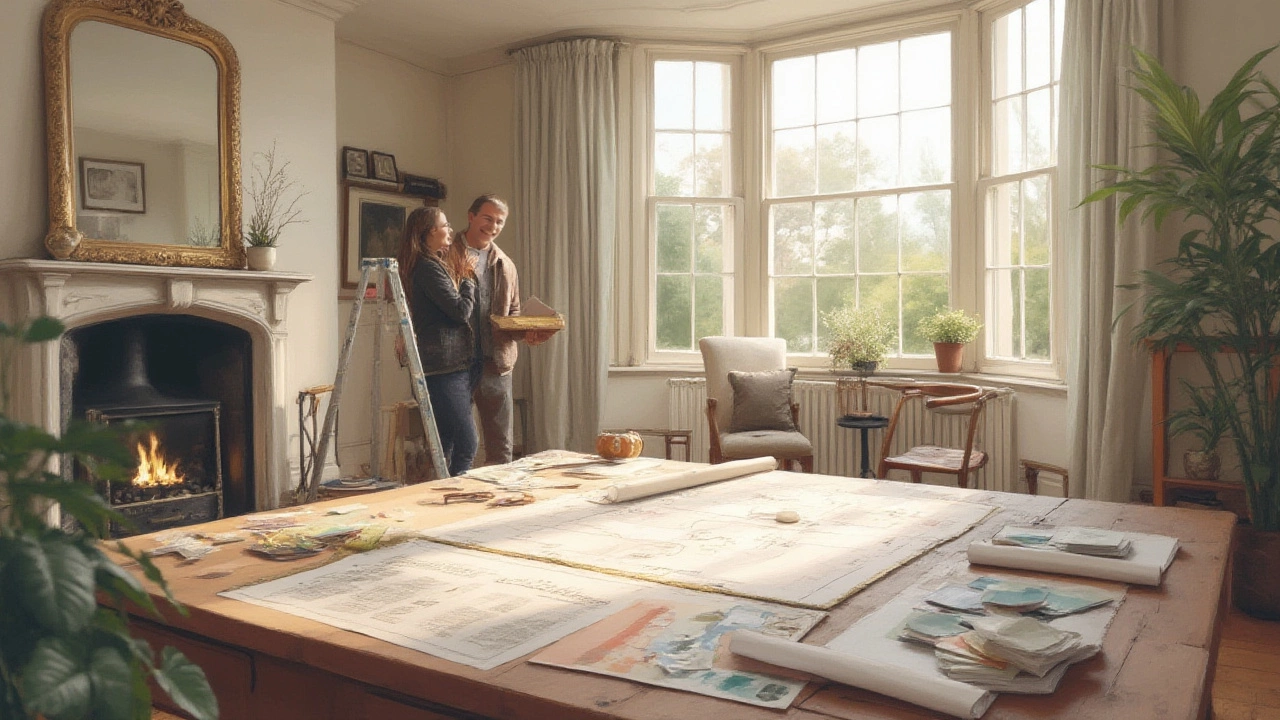Ever notice how a perfectly decorated room feels effortless? It isn’t magic—it’s method. Tons of people get stuck halfway, feeling lost somewhere between paint samples and sofa choices. The problem is almost always the order they decorate in. Start wrong, and it’s chaos: rugs bought before measuring, art that clashes with the wall, pillows without a purpose. Skip the confusion. Here’s how to decorate a room so it just clicks, from first idea to last lampshade.
Start with the Basics: Planning, Measuring, and Mood
Jumping right in with a shopping spree sounds fun, but let’s face it—that’s how you end up with a lime green chair that literally goes with nothing. The smart move? Commit to planning before dropping a dime. First, take honest measurements of everything—the room’s length, width, and especially the height if you want drama with curtains or light fixtures. According to an IKEA home study (2024), nearly 40% of home decorators returned at least one major item because it didn’t fit. So, get that tape measure and draw a basic floor plan. Don’t just stop at the big stuff—plug in window dimensions, radiator positions, and any awkward corners.
Now for the mood. Scroll Pinterest, save that jaw-dropper from Instagram, tear pages out of magazines. Notice what colors, finishes, and patterns you genuinely love—not just what’s trending. Even just picking three adjectives—like ‘calm,’ ‘bold,’ or ‘cozy’—gives you a filter for every future decision. Mood boards aren’t just for designers. Try free digital tools like Canva or Morpholio Board to drop in paint swatches, furniture, textures, and your favorite artwork. You’ll see right away if that jungle wallpaper works with your grandma’s chair. If you’re visual, printing your board or taping it to the wall might keep you from veering off course.
As you plan, think about function. Who actually uses the space? Are you working from home, hosting dinner parties, or housing two golden retrievers? How many people sit there on an average day? Design is about making daily life easier. According to a National Association of Realtors survey, 63% of people regret not considering their actual needs when decorating—not just looks. Avoid that. Map your traffic flow. Mark potential zones—reading nook, dining corner, etc. And always, decorate a room for the life you have, not the house you wish you lived in.
| Step | Task | Key Tool |
|---|---|---|
| 1 | Measure room and jot a floor plan | Tape Measure, Graph Paper |
| 2 | Create a mood board | Canva/Morpholio, Magazine Clippings |
| 3 | Identify key daily functions | Sticky Notes, Checklist |
Set the Foundation: Flooring, Walls, and Ceilings First
If decorating was a sandwich, the base isn’t lettuce or cheese—it’s your floors, walls, and ceilings. Get these right before even thinking about furniture. A new floor? Install it before anything else enters. Polishing up original hardwood or swapping to a washable laminate? Dust and debris from the work will ruin any fresh sofa or curtain you add. According to HomeAdvisor’s 2024 cost guide, about 31% of renovation budgets go toward foundational work—proof it pays to do this first.
Don’t skip walls. Choose your paint color after planning your palette, not in isolation. Ever see taupe on the paint chip and hate it on your wall? Natural light, shadow, and even the ceiling color change its look dramatically. Paint test swatches on every wall. Experts at Sherwin-Williams recommend viewing them morning, afternoon, and night before making a final call. If wallpaper’s your thing, measure walls carefully and don’t forget tough spots like windows or baseboard gaps. For texture or molding, plan before painting, and finish all these projects before any furniture moves in.
The ceiling sets the mood, too. A crisp white can feel fresh and open, while a bold ceiling color adds interest (and hides the odd cobweb). Now’s the moment for any lighting changes—installing overhead fixtures or adding dimmers (hello, mood lighting) is dramatically easier with an empty room. A licensed electrician can help if you’re going beyond basic swaps. Once the layers—flooring, walls, and ceiling—are done and dry, deep clean the room. Any construction dust or paint splatter sticks out like a sore thumb on your new pieces.
| Area | Most Popular 2024 Choices |
|---|---|
| Flooring | Luxury vinyl plank, engineered wood, patterned tile for entries/bathrooms |
| Wall Treatment | Early 2000s greens, warm neutrals, bold accent wallpaper |
| Ceiling | Flat white, crown molding, soft pastel hues |
One more tip: Don’t put down rugs yet. Wait until furniture’s in place—it’ll help you size and orient them properly. Think of floor coverings as the outfit’s shoes, not its base.

Arrange the Big Pieces: Furniture Placement and Flow
Here comes the fun part—filling the blank canvas. Before you buy, map out full-scale shapes with painter’s tape or newspapers. It’s so much easier to visualize that eight-foot sofa or see if a queen bed leaves room to walk (or if you need to size down). A survey by Apartment Therapy in July 2025 found over 51% of failed room makeovers started with buying the wrong scale furniture. Don’t fall into the trap—always measure doors, stairs, and elevators if you live in an apartment building. Nobody loves returning a three-piece sectional that can’t fit past the banister.
Start from the biggest piece out. In a living room, that’s usually the sofa; in a bedroom, the bed; in a dining room, the table. Position these against your floor plan and move them around if the flow feels wrong. Give enough space to easily walk between furniture—about 30 to 36 inches is a comfortable minimum between things like a coffee table and the sofa or a bed and the dresser. For tiny rooms, scale down—look for double-duty pieces, like benches with storage or nesting tables.
Once the anchors are set, add secondary seating—armchairs, love seats, poufs—as well as big storage like bookcases and wardrobes. If you can’t afford everything at once, prioritize the biggest pieces and go slow. Quality wins over quantity every time. According to a 2024 Houzz survey, most designers agree that patience pays off, and buying all at once usually leads to more regrets than buy-as-you-go.
| Room | Main Anchor Piece | Typical Clearance |
|---|---|---|
| Living Room | Sofa/Sectional | 30-36" around sofa tables, walkways |
| Bedroom | Bed | 24-36" on either side, more at foot |
| Dining Room | Dining Table | 36" between table and walls |
“Your room is only as comfortable as the distance between its furniture. Don’t sacrifice flow for a bigger piece.” — Nate Berkus, interior designer
Be honest about what fits—edit, edit, edit. There’s nothing wrong with a negative space. It lets your best pieces breathe and highlights them. Don’t crowd a good thing. Now is a good time to roll out your area rugs under furniture, aligning them with the main shape of the room. This not only grounds the seating group, but it protects your floors.
Add Personality: Textiles, Lighting, Accessories, and Art
So you’ve got walls, flooring, and big furniture—now, the soul enters the space. Start layering in textiles: throw pillows, blankets, curtains. Stick to your color palette, but don’t be afraid of a little mismatch. According to a Good Housekeeping feature from February 2025, the most beloved rooms mix at least three different textures: smooth leather, chunky knit, silk, or woven jute. Fabrics soak up sound, making a room feel cozy. When picking pillows or throws, remember odd numbers (three, five) tend to look more organic than pairs.
Lighting is next. Designers always say, “layer your lighting”—and it works. Combine overhead lights, table lamps, floor lamps, and wall sconces at varying heights. Dimmers are your friend—no one wants surgery-room glare at movie night. Position lights for tasks (reading, working) but also for mood. According to the Illuminating Engineering Society, indirect lighting (like a lamp bouncing off the ceiling) is easiest on the eyes and makes the space feel bigger. Swap in LED bulbs: They’ve jumped over 90% in energy efficiency since 2019, saving on bills.
Accessories finish the job. Group decorative items by odd numbers too, and vary their height and material—try a trio with a vase, a candle, and a family photo. Arrange art at eye level (about 57" in the center, per Smithsonian guidelines). Don't crowd walls—one large print beats seven small ones fighting for attention. As for shelves, leave space between objects to show restraint.
Finally, bring in plants or florals for a clear, fresh feel. Even if you’re not the green-thumb type, start small—succulents, snake plants, or faux options. According to an RHS report (January 2025), having greenery inside correlates to a 17% bump in feelings of well-being for city dwellers. Clean lines, simple objects, and calm colors all combine for a space you’ll actually want to spend time in. Step back, sip your coffee, and admire your work. The order you followed is what made it all feel so seamless.


